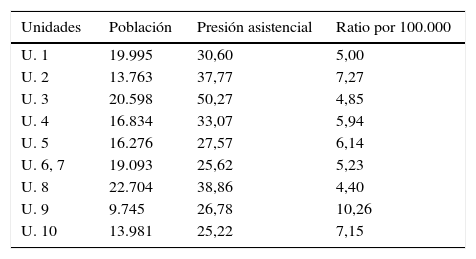Describir la actividad de las Unidades de Fisioterapia del Área III del Principado de Asturias, analizar la procedencia de los pacientes tratados y la demora en cada unidad en función de la ratio poblacional (fisioterapeuta/población) y los pacientes tratados procedentes de Atención Especializada (AE).
Material y métodoEstudio observacional, descriptivo. Período de estudio: primer semestre del 2013. Fuente de información: Sistema de Información de Atención Primaria del Programa Lázaro. Análisis descriptivo de la información mediante medias, desviación típica y rango y distribuciones porcentuales utilizando la regresión lineal para el análisis bivariante mediante el paquete estadístico: SPSS-PC+.V.11.0.
ResultadosLa presión asistencial fue de 29,58 consultas diarias, con un rango entre 25,22 y 50,27. Un 11,03% de los pacientes tratados procedían de AE, con rango 0,35 a 35,32%.
El coeficiente de correlación de la presión asistencial en las unidades en función de la ratio poblacional fue de –0,70 (IC: [–2,34]-[0,94]); el de los días de espera para iniciar tratamiento de–0,46 (IC: [–8,36]-[–1,01]) y –0,096 (IC: [–0,64]-[0,45]) el de demora para iniciar tratamiento según la proporción de pacientes derivados desde AE que asume la unidad.
ConclusionesPresión asistencial desigual entre unidades superando los estándares recomendados.
Las unidades más alejadas del hospital, con menor población, registraron menor presión.
No existe asociación entre población asignada a la unidad y su presión asistencial.
Existe relación entre ratio fisioterapeuta/número de habitantes y demora para iniciar tratamiento.
Existe diferencia en el número de pacientes tratados procedentes de AE entre unidades.
No se encuentra relación entre número de pacientes tratados procedentes de AE y demora para iniciar tratamiento.
To describe the activity of Area III Physiotherapy Unit of the Principality of Asturias. To analyze the origin of the treated patients and the delay occurring in each Unit based on the population ratio (physiotherapist/population) and treated patients coming from Specialized Care.
Material and methodDescriptive, observational study. Study period: First half of 2013. Information Source: Information System for Primary Health. Lazaro Programme. Descriptive analysis of the information by means, standard deviation and Range and percentage distributions, using the Linear Regression for the bivariate analysis and the SPSS-PC+V.11.0 statistics program.
ResultsThe care load burden was of 29.58 daily medical consultations, with a range oscillating from 25.22 to 50.27. Specialized carried accounted for 11.03% of the treated patients, with a range of 0.35 to 35.32%.
The care load coefficient correlation in the Units based on the population ratio was–0.70 (CI: [–2.34]-[0.94]). Days spent waiting for treatment to start was–0.46 (CI: [–8.36]-[–1.01]) and delay for starting treatment according to the proportion of referred patients from PC to the Unit was –0.096 (CI: [–0.64]-[0.45])
ConclusionsCare load differed between the Units, exceeding the recommended standards.
The Units that were farther away from the hospital, with less population, registered less burden.
There is no association between population assigned to the Unit and its care burden.
There is relation between physiotherapist/number of inhabitants and delay for starting the treatment.
A difference has been found between the number of treated patients coming from PC among the Units.
No relation was found between number of treated patients coming from PC and the delay for starting the treatment.
Artículo
Si ya tiene sus datos de acceso, clique aquí.
Si olvidó su clave de acceso puede recuperarla clicando aquí y seleccionando la opción "He olvidado mi contraseña".Comprando el artículo el PDF del mismo podrá ser descargado
Precio 19,34 €
Comprar ahora











